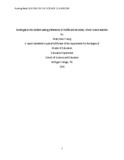| dc.description.abstract | Knowing how and where to sit students in the classroom is a key component in managing student behavior and creating the best environment for student achievement. In some instances, an educator may have a boisterous classroom where students talking unnecessarily is a discipline issue. The teacher may want to assign seats to students and place them in areas of the class where they are less likely to talk and be disruptive. Another facet to consider is how the students are arranged. Rows, circles, and groups are just a few ways that teachers can position their students and each arrangement has its own benefit. The purpose of this research is to explore this topic in greater detail to answer the question: Is there an optimal seating method that can be used in the science classroom to maintain discipline and improve student achievement? A qualitative approach was utilized to gather information by interviewing secondary science teachers about their seating preferences. Themes were identified and recommendations have been made as to the most efficient way to maintain discipline in the classroom while stimulating achievement through seating. | en_US |

